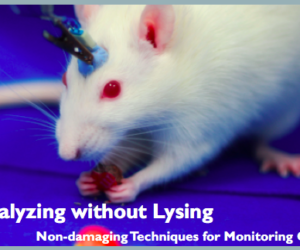Non-damaging Techniques for Monitoring Cells
Studying the interior of cells offers insight to the biochemical processes occurring. However, the process of collecting data involves bursting the cell open in a process called lysing that may also destroy important biochemical interactions. Researchers at Stanford University and the University of Michigan are developing technologies at the micro- and nano-scale level to obtain more reliable data and create a platform for monitoring drug metabolism.
Keywords: in vivo studies, lysing, nanostraws, microdialysis.
Editors: Whit Froehlich, Ada Hagan, and Irene Park
Originally posted by Michigan Science Writers.
Note: I must apologize that some of these journal articles are not open access. If you are interested in reading the original source, please message me here.
The interior of a cell is inherently complex with a myriad of processes going on all at once. Despite the clean images that are commonly shown in diagrams and textbooks, the parts inside are more of a whirlwind of structural components, proteins, and products (see Figure 1).

Because of its complexity, trying to figure out what’s going on within a whole cell is difficult. So instead, researchers look at parts of a cell and try to piece the puzzle back together. One way to study a part of a cell is called the in vitro approach, which uses biological components taken outside of their cellular system, such as on a culture dish. Even though findings from these in vitro experiments show meaningful results, they might be too simple to be reasonable or applicable to larger systems like tissues or a whole organism.
However, if the in vitro studies are promising, researchers will turn to in vivo approaches to study the processes in a living organism, such as cells and mice. But many times the in vivo experiment involves lysing, or bursting, the cell. This disruption could destroy the very processes that we are trying to study. As the cells are being torn apart, we could be disrupting the cellular components (e.g. protein-protein interactions) important to these processes.
Is there a way to study a living cell without lysing it?
Nano- and Micro- Technologies
Such concerns have led to the invention of new methods and technologies to study cellular contents without destroying them. One technique aims to collect small quantities from the cell for non-destructive monitoring by using nanostraws, which are small hollow cylinders that are 150nm in diameter. This is almost a thousand times thinner than a width of a single human hair.
Researchers at Stanford University have used the nanostraws to penetrate the cell membrane and extract picoliters (trillionths of a liter) of cellular components. This sampling system, called nanostraw extraction (NEX), works not unlike a CapriSun. A small straw is inserted without damaging the rest of the package, but instead of slurping up all the juice, only a very small amount, on the order of picoliters, is collected (see Figure 2).

Nanostraws attempt to mimic the biological process of nutrition transport between cells. Within our bodies, there is a network of gates, called gap junctions, that act as channels to permit cell-to-cell transfer of materials like ions or small molecules. Instead of exchanging contents with the cell, nanostraws remove the materials for study.
When comparing cell contents from NEX experiments with lysed-cell experiments, the Stanford researchers found 90% similarity between samples, demonstrating that NEX can be a great alternative for studying cells without lysing them.
Here at the University of Michigan, a similar non-damaging probing system is being developed to measure the levels of neurotransmitterswithin the brains of living organisms. Micrometer probes, which are slightly larger than nanostraws, are placed inside of the brain of a mouse to monitor its chemical levels in real time. This high-sensitivity probe can detect up to 27 neurotransmitters at once – in a living mouse, while it is moving!
The probe works by microdialysis, which uses passive diffusion to collect small molecules like neurotransmitters. Passive diffusion is the movement of particles from a high concentration to a low concentration. Because the tube is typically only filled with water or buffer with no neurotransmitters, the neurotransmitter concentration is higher in the brain—causing the neurotransmitters to pass through the dialysis membrane pores and into the tube.
This technology has been used to measure neurotransmitter levels within the brain, and researchers can then determine the relationship between neuronal activity and behavior. For example, it can be used to track how chemical levels change based on eating, which then explain the brain’s response.

The current applications of this technique are primarily for animal studies, but because it’s non-invasive, it’s increasingly being used in humans to monitor small biological molecules. Currently, the technology measures neurotransmitters like dopamine or serotonin, amino acids, and molecules involved with energy metabolism, like glucose or pyruvate.
Nanostraws and micrometer probes, though they still need improvement, are novel ways to study cells and tissues without destroying them. Using these techniques could lead to more accurate analyses by eliminating concerns about cellular metabolites being destroyed in the experimental process.
The techniques also grant the ability to repeatedly test the same organism, and even the same cell. This real-time approach allows researchers to study cellular processes continuously rather than using different samples and assuming that what happens in one cell also happens in another cell. The technology could be applicable in many fields of research, including drug research. For instance, researchers can monitor how a drug directly alters cellular processes over time, allowing for more precise improvement in dosing regimens to maintain suitable drug levels.
Sarah Kearns is a second-year PhD student at the University of Michigan studying Chemical Biology. She studies the recognition and mechanism of exchange of a CH3 group between enzyme and substrate in the Trievel Lab. Outside of the lab, she writes for MiSciWriters for which she serves as a content editor and as the communications director. She has her own blog, Annotated Science. and is on Twitter. Read more of her work with MiSciWriters here.


Leave a Reply